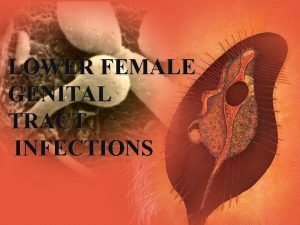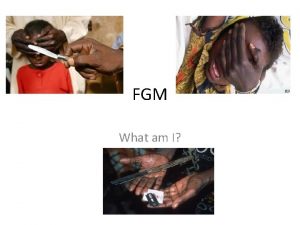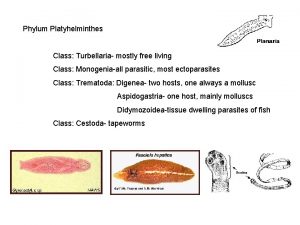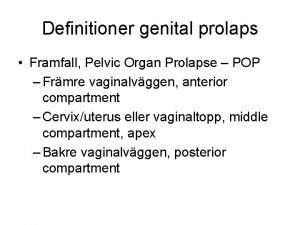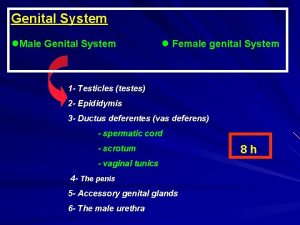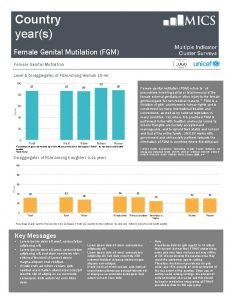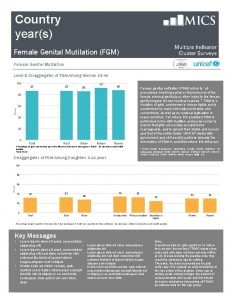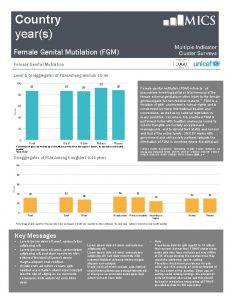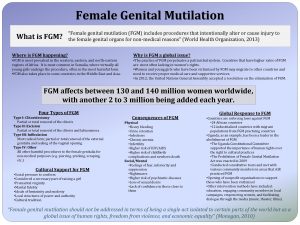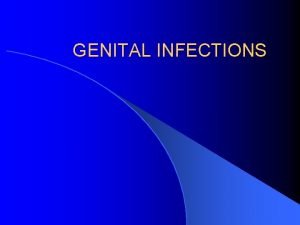Female Genital System Lecture 5 Introduction The female





![The Functions of Female Reproductive System: Produce sex hormones p Produce functioning gamates [ova] The Functions of Female Reproductive System: Produce sex hormones p Produce functioning gamates [ova]](https://slidetodoc.com/presentation_image_h2/7d1e54fb70824398981e601a61fe6793/image-6.jpg)



























- Slides: 33

Female Genital System Lecture# 5

Introduction The female reproductive system includes the ovaries, fallopian tubes, uterus, vagina, vulva, mammary glands and breasts. These organs are involved in the production and transportation of gametes and the production of sex hormones.

The Organs: Ovaries: are a pair of small glands, located on the left and right sides of the pelvic body cavity lateral to the superior portion of the uterus. The ovaries produce eggs and hormones. Fallopian tubes : are a pair of muscular tubes that extend from the left and right superior corners of the uterus to the edge of the ovaries

Uterus is a hollow, muscular, pear-shaped organ located posterior and superior to the urinary bladder. It surrounds and supports the developing fetus during pregnancy. It is divided into two parts: the cervix, and the main body of the uterus, called the corpus. Vagina is a canal that joins the cervix Vulva: is the collective name for the external female genitalia located in the pubic region of the body.

Breasts and Mammary Glands The breasts are specialized organs of the female body that contain mammary glands, milk ducts, and adipose tissue. The mammary glands are a special type of glands that have been modified to produce milk to feed infants. Within each breast, 15 to 20 clusters of mammary glands become active during pregnancy and remain active until milk is no longer needed.
![The Functions of Female Reproductive System Produce sex hormones p Produce functioning gamates ova The Functions of Female Reproductive System: Produce sex hormones p Produce functioning gamates [ova]](https://slidetodoc.com/presentation_image_h2/7d1e54fb70824398981e601a61fe6793/image-6.jpg)
The Functions of Female Reproductive System: Produce sex hormones p Produce functioning gamates [ova] p Support & protect developing embryo p


Female Reproductive System Disorders

Irregular Periods Menstrual cycle that has wide variations in the length of time between periods or variation the number of days of period. • Most common just after puberty and just before the menopause The average menstrual cycle lasts 28 days, but periods may occur as often as every 24 days or as infrequently as every 35 days or more. Menstrual bleeding normally lasts between 2 and 7 days, with the average length of bleeding being 5 days.

What are the causes? - Stress, excessive exercise - Being underweight or overweight -Temporary hormonal imbalance. -A disorder of the ovaries or of the uterus. e. g. polycystic ovary syndrome -In some cases, the cause is unknown.

Treatment: Irregular periods after puberty and just before the menopause treatment is not usually necessary. Other causes, drugs, such as oral contraceptives Relax after work and make time to de-stress. Eat well all month. Diagnosis: A pregnancy test Blood tests to measure hormone levels Ultrasound scanning of the pelvic region to look at the ovaries and uterus.

Dysfunctional Uterine Bleeding (DUB) Also called abnormal uterine bleeding (AUB) or anovulatory, any bleeding from the vagina that varies from a woman's normal menstrual cycle resulting from changes in the hormonal control of menstruation • This can include alternating periods that are heavy and light, spotting or unpredictable shorter and longer cycles. Dysfunctional uterine bleeding occurs most commonly at the beginning and end of the reproductive years, but may occur at any time.

Causes Regular monthly menstrual cycles flush out the endometrial lining, which is the blood-enriched layer of tissue that grows inside the uterus every month in expectation of a possible pregnancy. If ovulation does not occur, periods can be delayed, which allows the lining to grow thicker. For this reason, delayed periods are often heavy ones. Lighter periods, or spotting between periods, may represent an endometrial lining that is unstable and leaking, either because hormonal levels don't adequately support it or because the lining may be too thick.

Other factors that can change bleeding patterns include: • Hormonal abnormalities • Medications • Excessive exercise or weight loss • Obesity • Stress or illness • The end of menstruation — Dysfunctional uterine bleeding is common in the months to years before menopause.

Symptoms • Occur more frequently • Occur frequently and irregularly between periods • Involve more blood loss but occur at regular intervals • Involve more blood loss and occur frequently and irregularly between menses Diagnosis Pregnancy — Urine or blood tests • Thyroid hormone and prolactin hormone abnormalities — Blood tests • Menopause (especially in women in their 40 s or 50 s) — Blood tests to determine if estrogen levels are falling, which suggests the beginning stages of menopause • Abnormalities of the uterus or ovaries —

Preeclampsia Occurs when a pregnant woman has high blood pressure and protein in her urine at any point after her 20 th week of pregnancy. It only occurs during pregnancy, although in some cases, it can occur earlier than the 20 th week. Who is at risk : • being pregnant with multiple fetuses • first pregnancy • obesity • history of hypertension or diabetes • history of kidney disorder • Women older than age 40

Symptoms • High blood pressure • Severe headaches • Abnormal swelling in hands and face • Sudden weight gain • Changes in vision • • Excess protein in urine (proteinuria) Causes • The exact cause of preeclampsia (a result of a placenta that doesn't function properly) is unknown • Genetic factors • Diet • Blood vessels problems (narrower than normal BV) Autoimmune disorders

Treatment Delivery of a baby is the only cure for preeclampsia. If preeclampsia is mild, doctor may recommend: • bed rest • reduced salt intake • regular doctor’s visits • In some cases, may be given medications to help lower blood pressure.

Polycystic Ovary Syndrome (PCOS) Multiple, small, fluid-filled cysts in the ovaries associated with a sex hormone imbalance The cysts are not harmful but lead to hormone imbalances. For example: • The sex hormones get out of balance. Normally, the ovaries make a tiny amount of male sex hormones (androgens). In PCOS, they start making slightly more androgens. This may cause you to stop ovulating, get acne, and grow extra facial and body hair.

• The body may have a problem using insulin, called insulin resistance. When the body doesn't use insulin well, blood sugar levels go up. Over time, this increases your chance of getting diabetes. Risk Factors: • Affects females of childbearing age • Sometimes runs in families • Lifestyle is not a significant factor • A family history of diabetes

The symptoms • Irregular periods • Obesity. • reducing fertility • Excess androgen: excessive hair growth on the face, and/or on the lower abdomen, hair loss from the scalp, long -lasting acne. Women with PCOS have an increased risk of developing diabetes mellitus, high blood pressure , coronary heart disease, and cancer of the uterus.

The cause of polycystic ovary syndrome (PCOS) is not fully understood, but genetics may be a factor. PCOS problems are caused by hormone changes. One hormone change triggers another, which changes another

Diagnosis Blood samples to measure levels of sex hormones. Ultrasound scanning to look for ovarian cysts. Treatment Infertility can be treated with drugs If drugs are unsuccessful, the cysts may be treated with diathermy (a type of heat treatment). Abnormal periods can be treated with a combined oral contraceptive pill. To treat insulin resistance by drugs Losing weight may help to relieve symptoms of PCOS.

Cancer of the Cervix Occurs when abnormal cells on the cervix grow out of control. The cervix is the lower part of the uterus that opens into the vagina Risk factors: • Most common between the ages of 45 and 65 • Many sexual partners and Early sexual activity • Smoking are risk factors • Genetics is not a significant factor • A weak immune system

Symptoms: Early-stage cervical cancer generally produces no signs or symptoms. Signs and symptoms of more-advanced cervical cancer include: • Vaginal bleeding after intercourse, between periods or after menopause • Watery, bloody vaginal discharge that may be heavy and have a bad odor • Pelvic pain

Causes: Various strains of the human papillomavirus (HPV), a sexually transmitted infection, play a role in causing most cervical cancer. But not all types of HPV cause cervical cancer. Diagnosis A smear test A colposcopy A sample of tissue

Prevention • Get vaccinated against HPV. Vaccination is available for girls and women ages 9 to 26. • The vaccine is most effective if given to girls before they become sexually active. • Have routine Pap tests or cervical smear can detect precancerous conditions of the cervix, so • Don't smoke.

Breast Cancer A cancerous growth that originates in the breast Is the most common cancer diagnosed in women Breast cancer can occur in both men and women, but it's far more common in women

Risk factors: • Being female • Risk increases with age • A personal history of breast cancer. • A family history of breast cancer • In some cases, due to an abnormal gene • Radiation exposure • Beginning your period at a younger age. (before age 12) • • Beginning menopause at an older age. • • Having your first child at an older age. • Obesity, smoking, and delaying or avoiding pregnancy

The symptoms It is very unusual for breast cancer to produce symptoms in its early stages. When symptoms do occur, they usually affect only one breast and may include: • A breast lump or thickening that feels different from the surrounding tissue • Change in the size, shape or appearance of a breast • A swelling in the breast, breast which is usually painless and may be situated deep in the breast or just under the skin. • Swelling of the skin with an “orange peel” peel appearance. • Inversion of the nipple • A bloodstained nipple discharge

Causes It's not clear what causes breast cancer Gene mutations. How is it diagnosed? Recognize any abnormal changes. Screening using mammography Ultrasound scanning A fine-needle aspiration (a sample of cells is taken from the lump) Core biopsy(a sample of tissue is taken) An MRI scan of the breasts

Treatment of breast cancer may include surgery, radiotherapy, chemotherapy, hormone therapy, or, most frequently, a combination of these.

 Diagram of the women's reproductive organs
Diagram of the women's reproductive organs Tinedazole
Tinedazole Female genital mutilation
Female genital mutilation Mackenrodt's ligament
Mackenrodt's ligament Fgm uk
Fgm uk Internal genital organs female
Internal genital organs female 01:640:244 lecture notes - lecture 15: plat, idah, farad
01:640:244 lecture notes - lecture 15: plat, idah, farad Labeled female reproductive system
Labeled female reproductive system What std are curable
What std are curable Male genital variation
Male genital variation Genital hijyen
Genital hijyen Fijaciones de la etapa genital
Fijaciones de la etapa genital Genital atrium
Genital atrium Genital hijyen nedir
Genital hijyen nedir Genital hijyen nedir
Genital hijyen nedir Historia natural del herpes
Historia natural del herpes Hsv-2 oral transmission rates
Hsv-2 oral transmission rates Etapas del ciclo vital familiar
Etapas del ciclo vital familiar Shark genital
Shark genital Espace svt ac rennes dissection souris
Espace svt ac rennes dissection souris Tubercules quadrijumeaux
Tubercules quadrijumeaux Etapa locomotora genital
Etapa locomotora genital Etapa post parental
Etapa post parental External genital
External genital Genital atrium
Genital atrium External genital
External genital Function of male
Function of male Canal ejaculator
Canal ejaculator Latency stage clipart
Latency stage clipart Anal stage fixation
Anal stage fixation Tipos de corrimento fotos
Tipos de corrimento fotos Testis ne demek
Testis ne demek Framfall symtom
Framfall symtom L'appareil génital féminin en coupe frontale
L'appareil génital féminin en coupe frontale

